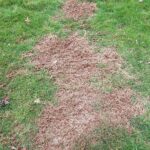Table of Contents
ToggleLast Updated on November 14, 2024
Every year countless homeowners evaluate their lawn and decide it is time to seed. They warn their lawn care technician in hopes of having them avoid the newly seeded areas. While it is important that the lawn care applicator/technician be aware of the newly planted seed, thinking the area needs to be avoided is a common mistake. Newly planted lawn should be maintained with as much diligence as established turf. This article debunks the misconception that new grass should be avoided and explains why the best thing is to do the exact opposite.
Feed the New Seed
What is new seed after all? It’s a whole bunch of baby grass plants. As with mature grass plants, an important aspect of seed germination is to “feed” the young plants with proper nourishment. Some people have the idea that you should avoid new grass plants with regularly scheduled applications; however instead of avoiding the seeded sections, we recommend using a specific fertilizer intended for new grass.
Not Just Any Plant Food
Like feeding infants baby formula, new grass plants need to be fed specially formulated plant food commonly known as starter fertilizer.
Starter fertilizer comes in granular and liquid formulations and can include a lot of different micronutrients, but true starter fertilizer must contain phosphorus in high doses. Phosphorus is the chief nutrient responsible for new growth and is used in greatest bulk by new plants for their development. New Jersey, in an effort to protect against its overuse, has laws prohibiting the application of fertilizers containing phosphorus during regular lawn maintenance. However, this nutrient is so critical for the young grass plants that the law makes exception for its usage in establishing new grass.
How necessary is it really to apply phosphorus? Can the plant just get that from the soil? Most of the phosphorus contained in the soil is bonded too tightly to the soil and cannot be extracted by immature grass roots. In addition to this, the newly forming grass roots are very shallow. Starter fertilizer containing the phosphorus needs to be delivered to the surface where roots can absorb the nutrient as it becomes available before it gets bound by the soil particles
What’s the Rush?
We want the new grass plants to mature as quickly as possible in order to withstand environmental conditions they will face. Whether it is the summer heat, drought stress, winter dormancy or disease; the well-established root system of mature grass plants have a better chance of surviving stressful environmental events compared to young grass.
Most seeding takes place in the spring or toward the end of summer. In the spring, the new plants need to mature as quickly as they can to develop a root system capable of supporting the plants through the upcoming summer. Therefore, it is extremely important to plant grass seed as early in the spring as possible (March or early April once snow cover is gone). The chances of getting a lot of desirable grass to germinate and establish in such a small window of time before summer heat arrives are already slim, so if the grass is to have any real chance at all, the process must be accelerated by applying starter fertilizer. For more information about seeding in the spring, check out our blog.
This same principle holds true for seeding that takes place at the end of summer, but obviously the race is against the cold instead of the heat. Therefore, larger seeding projects are best scheduled for this time as opposed to spring. Though the weather is more beneficial for longer, it is still important to appropriately fertilize the new grass to improve the overall turnaround on the seed. After all, having the highest percentage of new plants develop is often what categorizes the work as a success.
The final concern would be pathogenic fungi or turf disease. In trying to establish new seed, the areas addressed should be getting watered lightly at least once if not multiple times each day. While this is the correct way to ensure grass development, it can also promote unwanted disease activity. While the grass is very young, foliar diseases such as dollar spot, brown patch, and leaf spot can be very damaging to the plants. Feeding the plants with starter fertilizer will help them develop quicker and give them the nutrients they need to fortify themselves against potential threats.
Now You Know
While it is important not to treat the new seed inadvertently with potentially damaging herbicide, it can be equally damaging to avoid the area altogether. Next time you seed the lawn, speak with your lawn care technician about adjusting subsequent treatments and make sure that the new grass is addressed with starter fertilizer. Not only will he or she know to bring the correct product to the property each time, but they will also be able to monitor those areas during future treatments. Your lawn maintenance company is there to service the needs of the property and customize treatments whenever necessary. Be sure to take full advantage of all the benefits your company has to offer, not just for your established lawn, but for your new seed as well.
If you are in our service area and have questions about seeding or applying fertilizer, give our office a call or request a free estimate.


